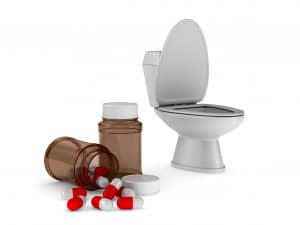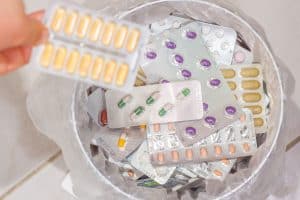What Medications Can Be Flushed? The Easy Guide to Drug Disposal
Posted by Prescription Hope - See Editorial Guidelines (Last Updated On: Thu Jul 13 2023)
Here we’re going to provide some definitive guidelines and recommendations on what drugs (if any) you can flush down your toilet or into the drainage and sewage system. The problems with flushing medications will also be discussed here.
What Medications Can Be Flushed? Generally, nothing should be flushed. The U.S. Food and Drug Administration (FDA) recommends “prescription take-back programs” or “household trash” as the two options for disposing of medications. Only a specific list of drugs is recommended to be flushed to avoid dangers from immediate consumption.
There are plenty of reasons why only certain medications can be flushed. The circumstances of flushing medications into the drainage system and its impact extends to the wider environment.
To give you some better guidance on this rather unknown but important topic, we’re going to provide you with the right guidelines in this article.

Why Flushing Medications Is Not The Best Option

It may seem easy and convenient to just flush your medications down the drain. It’s probably the first choice we make when it comes to disposing of medications, but we just don’t think about the implications.
Flushing medications can pollute water streams. It also unintentionally exposes us to the chemicals in the medications through water systems. Flushed medications do not disappear; they’re simply released through the drainage system and enter the water treatment system.
The water treatment system cleans up the water. But unfortunately, the drainage systems are not designed to remove or filter all the medications and related substances from the water when they become fully soluble.
This unfiltered water is what we end up potentially drinking. So, the harm starts from us and comes back to us. It’s a vicious cycle.
Recent studies have stated that flushing medications into the drainage system can contaminate natural water systems like lakes, streams, and rivers.
This continued release can seriously endanger aquatic species, as well as animals and wildlife.
Drugs such as hormones and antidepressants include endocrine-disrupting compounds (EDCs). These drugs tend to affect the reproduction, fertility and normal growth of aquatic species.
Fish and other aquatic species, and amphibian species, such as frogs, are affected by this contamination to a greater extent. The study also established how this method of flushing medications ends up contaminating the water we drink.
This is one of the main reasons why many state laws recommend different medication disposal alternatives. So, let’s get into what the best options are for you to dispose of your medications.
Disposing of Unused, Unwanted or Expired Medications
The best way and most recommended way of disposing of medications (both prescription and over-the-counter medication) is to drop them off in drop-off sites (drug take-back sites) or take-back programs. So, let’s take a look at each of these methods.
Drop-off Sites
In many countries, the sheriff and police facilities have permanent drop boxes in which you can deposit the medications you wish to dispose of. These boxes accept drugs such as prescription, over the counter and pet medications.
Only controlled substances may have a different approach depending on your state laws or guidelines, where some drop-off sites may accept controlled substances.
To find a drop-off site near you, you can call your county sheriff’s office or city police office to find out if there’s a permanent collection site near you.
Take-Back-Programs
Some states have authorized pharmacies that participate voluntarily in drug disposal programs. It’s these drug disposal programs that are known as drug-take-back programs.
It’s the pharmacist in charge who decides whether to enroll in this program or not. No one can force or mandate a pharmacy to involve in a take-back program.
According to the specification of a local ordinance and the state board of pharmacy, a small number of pharmacies accept general prescription drugs. These pharmacies then pass these medications to reverse distributors who will dispose of them.
If you don’t have prompt access to these locations, then you can use one of the two options below which the FDA recommends.
- If your medication is on the FDA flush list of drugs, then you can flush them. This will avoid potential dangers immediately.
- If your drug is not on the FDA flush list of drugs, then you must use appropriate instructions to discard the medication in your trash at home.

Drugs That Can Be Flushed Down the Toilet
The FDA approves the following list of drugs to be flushed only as a last resort.
That is only if drop-off sites or take-back programs are not available. Again, the below list consists mostly of controlled substances.
The reason is to ideally immediately dispose of them because it may be harmful or even deadly if they’re used by anybody else – other than the person they’re prescribed for.
If you’re unsure of what medications fall into the flushing category or if you don’t remember this FDA list you can check the prescription label or patient information leaflet to find disposal instructions.
You can also ask your pharmacists regarding the disposal of any medication you have. Here’s the list…
| Medication | Active Ingredient |
| Percocet (tablets) | Acetaminophen |
| Percodan (tablets) | Aspirin |
| Suboxone (film-sublingual) and Butrans (transdermal patch system) | Buprenorphine |
| Zubsolv (tablets- sublingual) and Buprenorphine Hydrochloride (tablets-sublingual) | Buprenorphine Hydrochloride |
| Diastat/Diastat AcuDial (rectal gel) | Diazepam |
| Abstral (tablets-sublingual) and Duragesic (extended-release) | Fentanyl |
| Fentora (tablets – buccal), Onsolis (soluble film-buccal) and Actiq (oral transmucosal lozenge) | Fentanyl Citrate |
| Dilaudid (tablets), Dilaudid (oral liquid) Exalgo and (tablets-extended release) | Hydromorphone Hydrochloride |
| Demerol (oral solution/tablets) | Meperidine Hydrochloride |
| Dolophine Hydrochloride(tablets), Methadone Hydrochloride (oral solution) and Methadose (tablets) | Methadone Hydrochloride |
| Daytrana (PDF – 281KB) (transdermal patch system) | Methylphenidate |
| Morphine Sulfate (tablets-immediate release), Morphine Sulfate (oral solution), MS Contin (PDF tablets – extended-release) and Avinza, (capsules-extended release) | Morphine Sulfate |
| Suboxone (film-sublingual), Zubsolv (tablets- sublingual) and Naloxone Hydrochloride (tablets-sublingual) | Naloxone Hydrochloride |
| Embeda (capsules- extended-release) | Naltrexone Hydrochloride |
| Oxecta, tablets (immediate-release), Oxycodone Hydrochloride (capsules), Oxycodone Hydrochloride (oral solution), Oxycontin (tablets-extended release), Percocet (tablets) and Percodan (tablets) | Oxycodone Hydrochloride |
| Opana, tablets (immediate release) and
Opana ER (tablets-extended release) | Oxymorphone Hydrochloride |
| Xyrem (oral solution) | Sodium Oxybate |
| Nucynta ER (tablets-extended release) | Tapentadol |
Note – The above list is continuously evaluated and amended by the FDA regularly for ensuring safety and eliminating risks, so be sure to check with them directly if you’re unsure.
If the medications don’t fall into this category and you don’t have access to any disposal programs or drop off sites, the FDA recommends your trash for disposal. But there are several specifications and steps that must be met when disposing of drugs using this method.
The Appropriate Method of Trash Disposal

Almost all the medications can be disposed of through trash. From prescription, over-the-counter medications. to varieties of pills, drops, inhalers, creams, and patches can be disposed of via the trash. But when using this method, the FDA recommends you follow these steps for ensuring safe disposal.
First, remove the medication from their original containers and mix them with some unappealing or foul-tasting items. The best choice would be coffee grounds, kitty litter or any other dark dirt.
This will make the medication less attractive for pets and children. Similarly, even the people who are intentionally searching through the trash for drugs may find it unrecognizable when it’s mixed up.
Note – Never crush pills and mix in with the trash. This makes the danger of disposing of a mix of medications worse. The dust from crushed drugs can easily be exposed to the skin and can even be inhaled by humans and pets creating implications for drug interactions.
Moreover, many pills are designed to release dosage over a period of time, so when crushed the dose could be much higher when it’s exposed to humans and animals, causing a greater health risk – particularly for women of childbearing age.
- After mixing, put the mixture into any sealable container. You can use Ziplock bags or any other used food cans for this.
- It’s after the second step you should throw away the medication (which is in the form of a mix in a sealed container)
- When throwing empty prescription containers, make sure you remove indicators of the drug, like the label. You should also remove any personal information in the containers to protect your privacy. Afterward, you can throw the package/container in the trash.
Even if medications are disposed of by following these steps, there are instances where curious kids can still get hold of them. Plus, especially when it comes to animals and pets, they’re not deterred by kitty litter or other substances when getting into the trash. This could expose them to these substances or even potentially ingest unused medications.
In fact, human medications are one of the leading causes of pet poisoning and especially from trash-related toxic exposures. Therefore, disposing of medications by using drop-off-sites or take-back-programs is the best-recommended method of drug disposal, over flushing or trash disposal.

To Close…
We hope this has been a useful resource for you. As always, take care of any drugs you dispose of, take responsibility for them and dispose of them correctly. Now more than ever we need to think about the environment and others when we do.
If you have any questions about how Prescription Hope can help you save money on any of the 1,500 medications that we offer, then visit our website here. If you’re having trouble affording any of the medications you’ve been prescribed, contact us, or visit the enrollment page to create an account and fill out an application to start saving.
ENROLL



